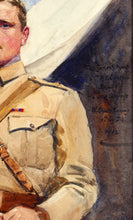Portrait of Second Lieutenant J.S. Mowat, 5th Royal Irish Lancers, late Imperial Yeomanry, 1902
Adding product to your cart
Overall: 49cm (19in) x 40cm (16in)
Watercolour on paper. Three-quarter length portrait seated in camp wearing field service uniform, Sam Brown belt, shoulder rank badges of a second lieutenant, and Queen’s South Africa medal ribbon. Inscribed centre right ‘To James S Mowat / 5th R.I. Lancers / from / his old comrade / W. Skeoch Cumming / 19th Coy I.Y. / 1902’. Framed and glazed.
Read more
Lieutenant-Colonel James Scott Mowat (1880-1948 ) was educated at Loretto. He enlisted in the Fife Light Horse in January 1900 and went as Trooper in the 20th (Fife and Forfar Light Horse) Company, 6th (Scottish) Battalion, Imperial Yeomanry to fight the Boers in South Africa. In June 1901 he was promoted in the field becoming Lieutenant in 5th Royal Irish Lancers on the recommendation of Lord Kitchener, the General Officer Commanding-in-Chief, South Africa. In April 1902 Mowat transferred to the Indian Army and was appointed to 26th King George’s Own Light Cavalry (late 1st Madras Lancers). During the First World War he served in Iraq, the Aden Hinterland and on the North West Frontier, being mentioned in despatches four times. He retired from the Indian Army in 1932 and settled in Sussex.
William Skeoch Cumming (1864-1929) was a Scottish watercolourist who trained at the Edinburgh School of Art and Royal Scottish Academy School and began his career as a scene painter at the Theatre Royal, Edinburgh. Like Mowat he volunteered for active service in South Africa against the Boer republics, joining the 19th (East Lothian and Berwickshire) Company, 6th (Scottish) Battalion, Imperial Yeomanry. He sailed from the Clyde in February 1900. During his service he took some 300 photographs (now in the Imperial War Museum) and made watercolour sketches of incidents and individuals. Cumming was invalided from South Africa with dysentery, and at home continued soldiering with the Scottish Horse. By all accounts Cumming ‘was a cheerful person, enjoying his freedom and his music’. He married Belle Sutton, another watercolourist, shortly before his death. His studio was at 28 Queen Street, Edinburgh before he moved to 31 Buckingham Terrace.






